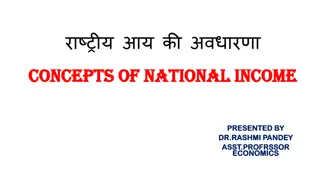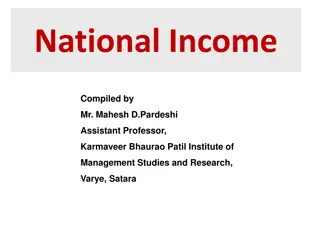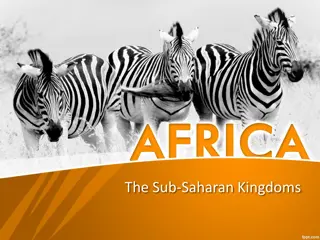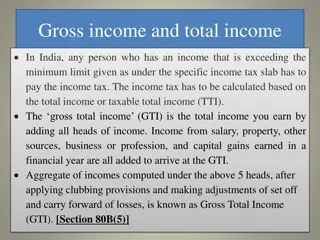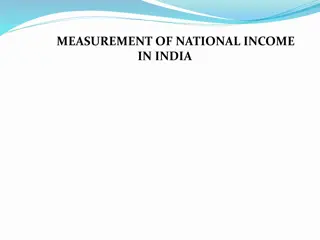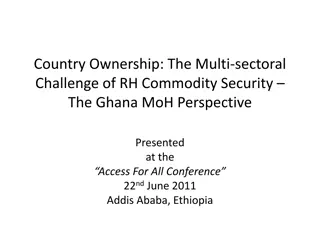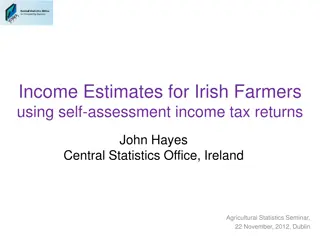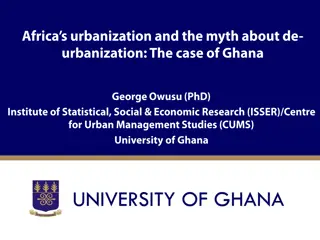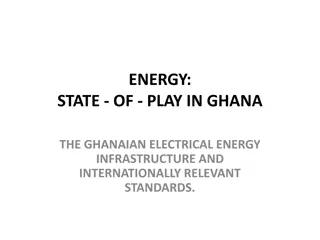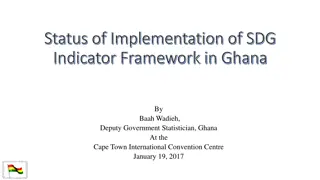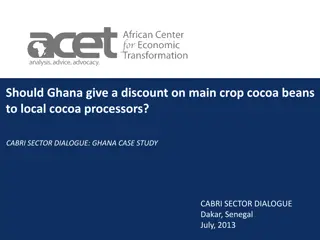Overview of Economy of Ghana - National Income Accounting
This session introduces students to the economic structure and developmental plans of Ghana, emphasizing the importance of national income accounting. The overview covers key topics to provide a general understanding of the country's economy.
Download Presentation

Please find below an Image/Link to download the presentation.
The content on the website is provided AS IS for your information and personal use only. It may not be sold, licensed, or shared on other websites without obtaining consent from the author.If you encounter any issues during the download, it is possible that the publisher has removed the file from their server.
You are allowed to download the files provided on this website for personal or commercial use, subject to the condition that they are used lawfully. All files are the property of their respective owners.
The content on the website is provided AS IS for your information and personal use only. It may not be sold, licensed, or shared on other websites without obtaining consent from the author.
E N D
Presentation Transcript
Lecturer: Dr. Emmanuel A. Codjoe and Dr. Michael Danquah Contact Information: ecodjoe.ug@gmail.com College of Education School of Continuing and Distance Education 2014/2015 2016/2017
Session Overview Session Overview: The importance of the study of the changes in the structure of the economy as well as the nature of economic activities of Ghana cannot be overemphasized. Thereby, this session seeks to introduce students to the general overview of the course. Goals/ Objectives: At the end of the session, the student will Have an idea of the structure of the course Have general knowledge of the economic structure of Ghana. Have a broad idea of the developmental plans which have been implemented in Ghana. Have general appreciation of the trends and contributions to the various aspects of the economy. Slide 2
Session Outline The key topics to be covered in the session are as follows: Topic One: Overview of Economy of Ghana Part 1 Topic Two: Overview of Economy of Ghana Part 2 Topic Three: Overview of Economy of Ghana Part 3 Slide 3
Reading List Refer students to relevant text/chapter or reading materials you will make available on Sakai Slide 4
Topic One OVERVIEW OF ECONOMY OF GHANA PART I: NATIONAL INCOME ACCOUNTING Slide 5
Why National Income Accounting? Numbers define our world whether as individuals, organisations and governments. Numbers tell us how well we are doing. Economists and analysts depend on numbers to determine the well-being of an economy. These numbers are usually termed leading indicators. E.g., GDP, unemployment, inflation, trade deficits, exchange rates. Slide 6
Why National Income Accounting? Every country needs to obtain a sense of how the economy performs over time. One way of achieving this is through the use of the national income accounts. Thus the national income accounts is used to obtain a sense of the aggregate performance of the economy. Slide 7
Why National Income Accounting? Cont d National income accounting refers to the set of rules and definitions for measuring economic activity in the aggregate economy. In other words, how we go about measuring the total economic output of goods and services in an economy over a given period of time. Slide 8
Topic Two OVERVIEW OF ECONOMY OF GHANA PART II: ECONOMIC PLANNING & EXTERNAL SECTOR Slide 9
Background to External Sector We can distinguish between two broad periods; pre-1983 and post-1983. Pre-1983 was marked by greater controls and interventions by government. Pre-1983 was characterized by several restrictions on trade and capital movements. These included, restrictions on international capital flows, quantitative restrictions on trade and high import tariffs. However, post-1983 marked the commencement of a marked and significant shift in economic paradigm away from a more interventionist regime. Slide 10
Current Trends in Ghanas External Sector Currently there are few restrictions on trade and capital flows. Ghana is actively engaged in attracting foreign investments as well as seeking to expand trade with other regions of the world. International trade continues to play a major role in Ghana s economic growth performance and holds the potential to promote structural transformation of the economy provided economic manager s show renewed interest in a trade-induced industrial policy deliberately directed at industrialization. Slide 11
Current Trends in Ghanas External Sector Cont d In 2014, international trade continued to contribute significantly to the nation s gross domestic product (GDP) and its level of development. Compared to 2013, however, Ghana s trade in 2014 contracted. Ghana registered a deceleration in international trade performance in 2014, compared to a slow but positive growth in recent years. This was due to the sluggish performance of both merchandise exports and imports. Slide 12
Brief Introduction to Economic Planning Ghana has a history of development planning that dates back almost 100 years. In 1920, the then Governor of the Gold Coast, Sir Gordon Guggisberg, unveiled a Ten-Year Programme (1920-1930) that in effect aimed to transform the mono-crop economy into a diversified and resilient one. The Programme covered everything from political and industrial maps to hydro-electric works to harbours, railways, water supply, and town improvements. Slide 13
Brief Introduction to Economic Planning Cont d The implementation of Guggisberg s Programme, however, came to an abrupt end in 1927, when he was suddenly re-assigned to British Guyana. Of the 24 million budgeted for the Programme, only 12.4 million was spent and yet it appeared to have achieved generally positive results, as indicated by the following: i. Link Akim Tafo to Kumasi by rail (completed) ii. Takoradi Harbour (completed) iii. Link Kumasi to Tamale by rail (not done) iv. Pra River Hydro Electric Project (not done) v. Korle Bu Hospital (completed) vi. Prince of Wales (Achimota School) (completed) vii. 3,380 miles of new road built between 1920 and 1927, in addition to 260 miles then in existence. Slide 14
Brief Introduction to Economic Planning Cont d The next major attempt at long-term development planning in Ghana was the 10-year Plan for the Economic and Social Development of the Gold Coast (1950-1960), which provided an outline of what it hoped will be achieved in all fields of development during the ten-year period beginning April 1, 1950. In an allusion to what economists call perspective (or long- term) planning, the document referred to the 10-year period as merely one phase in the development of the country which has been going on steadily for many years and will continue beyond the decade with which the plan is concerned. The Plan had a budget of 75.0 million. Slide 15
Brief Introduction to Economic Planning Cont d In 1951, however, following it s assumption of office, the Convention People s Party (CPP), seized by the urgency of the moment, collapsed the 10-year Plan into a 5-year plan (1951/52-1956/57) with a price tag of 117.6 million. Actual expenditure, however, came in at 93.7 million as the government cut back spending to offset falls in cocoa prices (and by extension revenue) over the period. The period 1957-1958 was devoted to a consolidationplan , which drew lessons from the previous plan in anticipation of another medium-term plan. In March 1958, the Second Five-Year Plan (1959- 1964) was presented to Parliament. Its total cost was 350 million, with 100 million of that amount going into hydro-electric development. Slide 16
In 1961, however, the Second Five-Year Plan was terminated in favour of a Seven-Year Development Plan for National Reconstruction and Development (1963/64- 1969/70) at a cost of 1,016 million Following the 1966 coup d tat, the Seven-Year Development Plan was terminated. However, it was already facing major implementation challenges as the world market price of cocoa, the mainstay of the economy and the major source of financing the Plan, had begun to fall in the early 1960s. Slide 17
Brief Introduction to Economic Planning Cont d The succeeding years were characterised by short-term plans, whose implementation was often undermined by the frequent changes in government and the attendant political turmoil that the country experienced from the latter half of the 1960s to the early 1980s. A notable exception was Operation Feed Yourself and Operation Feed Your Industries, an ambitious medium-term programme of self-reliance nationalisation of several multinationals under a strategy of seizing the commanding heights of the economy ) in the mid-1970s that saw a rapid expansion in agricultural output. (including the partial Slide 18
Brief Introduction to Economic Planning Cont d In 1995, the President presented to Parliament the first long-term national development plan under constitutional rule called, Ghana Vision 2020 (The First Step: 1996-2000), which aimed to transform the country into a middle- income one in 25 years. The Plan also represented the first Coordinated Programme of Economic and Social Development Policies, which the Directive Principles of State Policy requires every president to submit to Parliament within two years of assuming office. A medium-term plan, along with a Programme of Action for the First Medium-Term Plan (1997-2000) , was subsequently produced. Both, however, faced delays in production, with the Programme of Action being released in June 1998. With the change in government in 2001, the overall long-term plan, Vision 2020, was set aside. The new government cited persistent and wide disparities between planned targets and actual performance as among the reasons for the cancellation. Slide 19
The succeeding years were characterised by short-term plans, whose implementation was often undermined by the frequent changes in government and the attendant political turmoil that the country experienced from the latter half of the 1960s to the early 1980s. A notable exception was Operation Feed Yourself and Operation Feed Your Industries, an ambitious medium-term programme of self-reliance nationalisation of several multinationals under a strategy of seizing the commanding heights of the economy ) in the mid-1970s that saw a rapid expansion in agricultural output. (including the partial Slide 20
Brief Introduction to Economic Planning Cont d Vision 2020 was replaced with the Ghana Poverty Reduction Strategy (GPRS I; 2002-2005) and later the Growth and Poverty Reduction Strategy (GPRS II, 2006-2009). The replacement of Ghana with Growth in GPRS II was informed by what the government saw as the need to shift focus from poverty-related spending and redistributive policies to growth as a primary path to poverty reduction and ultimately eradication. With the change in government in 2009, GPRS II was succeeded by the Ghana Shared Growth and Development Agenda: 2010-2013 (GSGDA I), which was followed by the Ghana Shared Growth and Development Agenda: 2014-6 2017 (GSGDA II) Slide 21
Brief Introduction to Economic Planning Cont d Both documents were based on the Coordinated Programme of Economic and Social Development Policies. The emphasis on sharedgrowth was based on the new government s belief that high growth by itself would not reduce or end poverty unless it is accompanied by policies to make that growth inclusive, or shared . In effect, the GSGDAs represented a combination of the principles of equity and the ideals of high rates of economic growth that informed GPRS I and GPRS II, respectively Slide 22
Topic Three OVERVIEW OF ECONOMY OF GHANA PART III: AGRICULTURE, INDUSTRIAL, EDUCATION AND HEALTH SECTORS Slide 23
Agriculture is vital to the Ghanaian economy, accounting for food production, foreign exchange earnings and most importantly employing about 45.3% of the country s population. The sector was the major contributor to GDP growth until the last decade when changes in the contribution of the various sectors to the economy saw the upgrade of the services sector. The agricultural sector in Ghana is also undergoing transformation, moving gradually away from subsistence towards more mechanized and commercialized agriculture, backed by private and government initiatives and programmes. Slide 24
Current Issues in Ghanas Industrial Sector The industrial sector is made up of five sub-sectors namely (1) Mining and quarrying, (2) Manufacturing,(3) Electricity Generation and Distribution, (4)Water and Sewage and (5) Construction. In 2014, the economy of Ghana as measured by changes in its real gross domestic product (GDP) grew at rate of 4.0%. This rate was the lowest recorded over the eight-year period from 2007 to 2014. The decline of the growth of GDP in 2014 was due primarily to the relatively weak performance of the industrial sector, the second largest sector of the economy. This performance of the industrial sector was similar to the situation that occurred in 2007 when the country was also hit by an electricity energy production crisis Slide 25
Current Issues in Ghanas Industrial Sector Cont d The growth rate of the industrial sector in 2014 was 0.8%. this growth was the lowest of all the three sectors of the real economy with the agriculture and services sectors growing at 4.6% and 5.6% respectively. Despite the poor performance of the industrial sector in 2014 it remained the second largest sector after the services sector, accounting for 26.6% of GDP in 2014, compared to the 21.5% and 51.9% shares for agriculture and services sectors respectively. In 2014 the industrial sector was worth 8,542 million cedis in real 2006 (constant monetary) values compared to the level of 8,475 million cedis recorded in 2013. The corresponding sizes of the agriculture and services sector for 2014 were 7,362 million cedis and 16,679 million cedis respectively. Slide 26
Current Issues in Ghanas Education Sector The provision of quality education at all levels, more than merely providing access to basic education, remains a major developmental challenge for Ghana. A recent report (OECD, 2015) ranked Ghana bottom among 76 countries in the world (five from Africa) on educational achievement levels for school going 15-year-olds. Indeed according to the report, about 89% of youth in Ghana go through school without acquiring any basic skills. This is worrying by itself but more so for a developing country like Ghana because of the strong correlation between basic skills acquisition and economic and social development. Clearly, rather than just focus on attaining universal basic education Ghana must focus on achieving basic skills acquisition. Why? Because the latter can help triple Ghana s current GDP every four years (OECD, 2015), but focusing on only the former will likely produce a generation of frustrated youth. Slide 27
Current Issues in Ghanas Health Sector Health services are probably the most critical of all services sector activities. According to government s economic policy statements (Government of Ghana, 2014) key interventions in the health sector in 2014 include major infrastructure expansion and implementation of efforts to enhance health service delivery. The number of locations where the Community Health Planning and Services (CHPS) initiative was functional increased by 724 in 2014, bringing the total to approximately 3,040. this represents a 31% increase over the number in 2013, and this could accelerate Ghana s effort at achieving MDGs 4 and 5. Slide 28
Current Issues in Ghanas Health Sector Cont d Ghana s doctor density (the number of doctors per population of 1,000 people) is far from ideal, and worse than even the SSA average density- the doctor density of developing SSA is approximately 0.203, higher than Ghana s by a factor of 2.1g based on comparable data from the world Bank (World Bank, 2014). The gap is even wider (by a factor of 7.9 and 18.8 respectively) when comparing Ghana s situation with the average lower middle income country counterpart or the average upper middle income country model. Slide 29
References Slide 30


